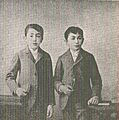Mehmed Sabahaddin facts for kids
Quick facts for kids Mehmed Sabahaddin |
|
|---|---|
| His Highness Prince Sultanzade Sabahaddin | |
 |
|
| Born | 13 February 1879 Istanbul, Ottoman Empire |
| Died | 30 June 1948 (aged 69) Neuchâtel, Switzerland |
| Spouse | Tabinak Hanım Kamuran Hanım |
| Issue | First marriage Fethiye Kendi Sabahaddin |
| Father | Mahmud Celaleddin Pasha |
| Mother | Seniha Sultan |
| Religion | Sunni Islam |
Sultanzade Mehmed Sabahaddin (born February 13, 1879 – died June 30, 1948) was an Ottoman prince. He was also a sociologist and a deep thinker. He was part of the ruling House of Osman (the Ottoman dynasty).
Sabahaddin wanted more democracy in the late 1800s and early 1900s. Because of his ideas and political actions, he was sent away from his home country. He helped start a political group called the Liberty Party, which didn't last very long.
Even though he was part of the royal family through his mother, Seniha Sultan, Sabahaddin was known as a Young Turk. This group was against the absolute rule of the Ottoman dynasty. Sabahaddin followed the ideas of Émile Durkheim, a famous sociologist. Because of this, Sabahaddin is seen as one of the people who started sociology in Turkey. In 1902, he created a group called the League for Private Initiative and Decentralization. This group focused on people taking their own actions and spreading power away from the central government.
Contents
Biography of Prince Sabahaddin
Early Life and Education
Mehmed Sabahaddin was born in Istanbul in 1879. His mother was Seniha Sultan. She was the daughter of the Ottoman sultan Abdulmejid I. His father was Mahmud Celaleddin Pasha. His father was the son of a Grand Admiral.
Prince Sabahaddin received a wide-ranging education at the Ottoman palace. In late 1899, he had to leave the country. He fled with his brother and father. His father had disagreed with Sultan Abdul Hamid II. They first went to Great Britain, then to Geneva in Switzerland. Geneva was a place where people who opposed the Ottoman Sultan gathered.
Political Opposition and Exile
After a warning from the Swiss government in 1900, they left Geneva. They moved to Paris and London. In the first part of his political opposition (1900–1908), he worked to unite Christians and Muslims. He met with leaders from both groups. He gained support for the Young Turks movement.
During this time, he met Edmond Demolins. Sabahaddin became a follower of Demolins' ideas about social sciences. Sabahaddin supported liberal economic policies. He promoted these ideas in his group, the League for Private Initiative and Decentralization. This group became a rival to another group called the Committee for Union and Progress (CUP), led by Ahmed Riza. This disagreement caused problems within the Young Turk movement before 1908. It also became a main point of debate in the Second Constitutional Era.
Return to the Ottoman Empire and Later Exile
After the Young Turk Revolution in 1908, the Committee of Union and Progress took power. Sabahaddin then returned to the Ottoman Empire. His Liberty Party was against the Committee of Union and Progress. It was banned in 1909, and he had to flee again. He also helped create the Freedom and Accord Party. During World War I, he led the opposition from exile in western Switzerland.
In 1919, Sabahaddin went back to Istanbul. He hoped to make his political ideas a reality. However, in 1924, he was banned by the new Turkish National Movement. This movement was led by Mustafa Kemal (later Atatürk). Sabahaddin's plan for a democratic Turkey included ideas like decentralization (spreading power) and private initiative (people taking their own actions). These ideas came from the social theories of Frederic Le Play and Edmond Demolins.
After the new Republic of Turkey was formed in 1923, a law was passed on March 3, 1924. This law sent all living members of the House of Osman out of Turkey. So, from this time on, Sabahaddin had to live in retirement in Switzerland. In 1952, Sultanzade Sabahaddin's remains were brought back to Istanbul. He was buried in the tomb of his father and grandfather.
Family Life
Sabahaddin had two wives:
- Tabinak Hanım (married 1898 - divorced 1961). They had one daughter:
- Fethiye Kendi Hanım Sabahaddin (1899 - 1986). She never married and had no children.
- Kamuran Hanım. She was Tabinak's younger sister. They married after Sabahaddin divorced his first wife.
Influences on Others
Sabahaddin had an impact on many people, even without knowing it. One person was John G. Bennett. Bennett met Sabahaddin in 1920. At that time, Bennett was working for the British Army in Istanbul after the First World War. Sabahaddin introduced Bennett to new ways of thinking. He encouraged Bennett to read a book called Les Grands Initiés ("The Great Initiates"). Sabahaddin also introduced Bennett to an English woman living in Turkey, Winifred "Polly" Beaumont. Bennett later married her. Among others Sabahaddin introduced Bennett to, the most important was G.I. Gurdjieff. Bennett considered Gurdjieff his teacher and guide for the rest of his life.
See also
- Sultanzade
- Young Turk
- Seniha Sultan
Images for kids


